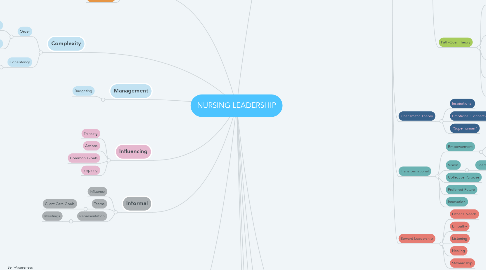
1. Complexity
1.1. Order
1.1.1. Planning
1.1.1.1. Predictability
1.1.1.2. Stability
1.1.2. Organizing
1.2. Consistency
1.2.1. Staffing
1.2.2. Problem Solving
2. CNA
2.1. Education
2.1.1. Leadership Course
2.1.2. Research
2.1.2.1. Policy
2.2. Administrators
3. Influencing
3.1. Thinking
3.2. Actions
3.3. Common Gioals
3.4. Inspiring
4. Management
4.1. Budgeting
5. Informal
5.1. Influence
5.2. Teams
5.2.1. Client Care Goals
5.3. Representation
5.3.1. Meetings
6. Emotional Intelligence
6.1. Meaning
6.1.1. Self-Awareness
6.1.1.1. Realistic
6.1.1.2. Grounded
6.1.1.3. Confidence
6.1.1.3.1. Critical Thinking
6.1.1.4. Preferences
6.1.2. Motivation
6.1.2.1. Preferences
6.1.2.2. Goals
6.1.2.3. Initiative
6.1.2.4. Perservance
6.1.2.5. Improvements
6.2. Reasoning
6.3. Relationships
6.3.1. Self-Regulation
6.3.1.1. Conscientious
6.3.1.2. Delayed Gratification
6.3.1.3. Recovery
6.3.2. Empathy
6.3.2.1. Perspective
6.3.2.2. Rapport
6.3.3. Social Skills
6.3.3.1. Insight
6.3.3.2. Stability
6.3.3.3. Smooth Interactions
6.3.3.4. Persuasion
6.3.3.4.1. Negotiation
6.3.3.5. Cooperation
6.3.3.5.1. Team Work
6.4. Problem Solving
7. Theories
7.1. Behavioural
7.1.1. Autocratic
7.1.1.1. Centralized DM
7.1.1.1.1. High-performing
7.1.1.2. Command
7.1.1.2.1. Hostility
7.1.1.3. Control
7.1.2. Democratic
7.1.2.1. Participatory
7.1.2.1.1. Positive Feelings
7.1.2.1.2. Strong Performance
7.1.2.2. Delegation
7.1.2.2.1. Low Productivity
7.1.2.2.2. Frustration
7.1.2.3. Relationships
7.1.3. Laissez-Faire
7.1.3.1. Passive
7.1.3.2. Permissive
7.1.3.3. Deferred DM
7.1.4. Initiating Structure
7.1.4.1. Task Focus
7.1.4.1.1. Goal Achievement
7.1.4.2. Production
7.1.4.2.1. Work Organization
7.1.5. Consideration
7.1.5.1. Employee Focus
7.1.5.1.1. Well-Being
7.1.5.2. Relationships
7.1.5.2.1. Communication
7.1.5.2.2. Trust
7.1.5.2.3. Respect
7.1.6. Blake & Mouton
7.1.6.1. Impoverished Leader
7.1.6.1.1. Low Production
7.1.6.1.2. Low People Concern
7.1.6.2. Authority Compliance Leader
7.1.6.2.1. High Production
7.1.6.2.2. Low People Concern
7.1.6.3. Country Club Leader
7.1.6.3.1. Low Production Concern
7.1.6.3.2. High People Concern
7.1.6.4. Middle-of-the-Road Leader
7.1.6.4.1. Moderate Production Concern
7.1.6.4.2. Moderate People Concern
7.2. Contingency
7.2.1. Fielder
7.2.1.1. Leader-Member Relations
7.2.1.1.1. Feelings toward leader
7.2.1.2. Task Structure
7.2.1.2.1. High Task Structure
7.2.1.2.2. Low Task Structure
7.2.1.3. Position Power
7.2.1.3.1. High Position Power
7.2.1.3.2. Low Position Power
7.2.2. Situational Theory
7.2.2.1. Telling Leadership Style
7.2.2.1.1. High Task Behaviour
7.2.2.1.2. Low Relationship Behaviour
7.2.2.1.3. Safety
7.2.2.1.4. Low Maturity
7.2.2.2. Selling Leadership Style
7.2.2.2.1. High Task Behaviour
7.2.2.2.2. High Relationship Behaviour
7.2.2.2.3. Low/Moderate Maturity
7.2.2.3. Participating Leadership Style
7.2.2.3.1. Low Task Behaviour
7.2.2.3.2. High Relationship Behaviour
7.2.2.3.3. Moderate/High Maturity
7.2.2.4. Delegating Leadership Style
7.2.2.4.1. Low Task Behaviour
7.2.2.4.2. Low Relationship Behaviour
7.2.2.4.3. High Maturity
7.2.3. Path-Goal Theory
7.2.3.1. Directive Style
7.2.3.1.1. Structure
7.2.3.2. Supportive Style
7.2.3.2.1. Encouragement
7.2.3.2.2. Interest
7.2.3.2.3. Attention
7.2.3.3. Participative Style
7.2.3.3.1. Involvement
7.2.3.4. Achievement-Oriented Style
7.2.3.4.1. Structure
7.2.3.4.2. Support
7.2.3.5. Expectancy Theory
7.3. Charismatic Theory
7.3.1. Inspirational
7.3.2. Emotional Connection
7.3.3. "Superhuman"
7.4. Transformational
7.4.1. Empowerment
7.4.1.1. Agents of Change
7.4.1.2. Inspiration
7.4.2. Vision
7.4.2.1. Shared Values
7.4.2.1.1. Courageous
7.4.3. Collective Purpose
7.4.4. Preferred Future
7.4.5. Innovation
7.5. Servant Leadership
7.5.1. Other's Needs
7.5.2. Empathy
7.5.3. Listening
7.5.4. Healing
7.5.5. Stewardship
8. Competencies
8.1. Specialized Knowledge
8.2. Judgement
8.3. Skills
8.4. Clinical Experience
9. Formal
9.1. Authority
9.2. Specialist
9.3. Practitioner
9.3.1. Community Development
9.4. Manager
9.5. Leader
9.6. Advanced Practice
9.7. Consultant
9.8. Servant & Leader
9.9. Researcher
9.9.1. Practice
9.9.2. Policy
9.10. Educator
10. Change
10.1. Direction
10.2. Empowerment
10.3. Movtivation
10.4. Inspiration
10.5. Achievement
11. Characteristics
11.1. Bennis & Nanus
11.1.1. Guiding Vision
11.1.1.1. Vision Statement
11.1.1.1.1. Preferred Future
11.1.1.2. Inspirational
11.1.1.2.1. Reach
11.1.1.3. Reference Point
11.1.1.3.1. Decision-Making
11.1.2. Passion
11.1.2.1. Inspirational
11.1.2.2. Alignment
11.1.2.3. Assistance
11.1.2.3.1. Patients
11.1.2.3.2. Clients
11.1.2.3.3. Families
11.1.3. Integrity
11.1.3.1. Knowledge of Self
11.1.3.1.1. Strengths
11.1.3.1.2. Weaknesses
11.1.3.1.3. Mistakes
11.1.3.2. Honesty
11.1.3.3. Maturity
11.1.3.3.1. Experience
11.1.3.3.2. Growth
11.1.3.4. Lifelong Learning
11.1.3.4.1. Daring
11.1.3.4.2. Curiosity
11.2. Olympic Thinking
11.2.1. Inspiring Vision
11.2.1.1. Preferred Future
11.2.2. Burning Desire
11.2.3. Purposeful Action
11.2.4. Visualization
11.2.4.1. Confidence
11.2.4.2. Motivation
11.2.4.3. Discipline
11.2.4.4. Focus
11.2.4.4.1. Achievement
11.3. Most Valued
11.3.1. Caring Nature
11.3.2. Respectability
11.3.3. Trustworthiness
11.3.4. Felxibility
12. Huston
12.1. Global Perspective
12.2. Technology Skills
12.3. Expert Decision-Making
12.4. Quality Health Care
12.4.1. Safety
12.5. Political Intervention
12.6. Collaborative
12.6.1. Team Building
12.7. Authenticity
12.7.1. Performance
12.8. Adaptation
12.8.1. Rapid Change
12.8.2. Chaos
12.8.3. Health Care System

